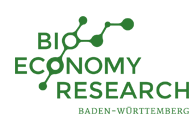Evaluation of pyrolysis oil as a platform substrate for fermentation
Pyrolysis oil, a complex mixture of organic compounds produced by flash pyrolysis of lignocellulosic materials (e.g. wheat straw), was investigated for its suitability as an alternative carbon source for biotechnological fermentation processes. The aim was to ensure the complete utilization of these organic substances and to identify substances that might accumulate and/or inhibit microbial growth.
As model systems, rhamnolipid production with Pseudomonas putida was investigated in subproject A and L-malic acid production with the filamentous mould Aspergillus oryzae in subproject B. In addition, further microorganisms were screened that can use pyrolysis oil as a carbon source.
In subproject A, the general suitability of pyrolysis oil to serve as a substrate for bacterial bioconversion was investigated. For this purpose, different fractions and methods for pretreatment were used (Arnold et al., 2018). It could be shown that P. putida KT2440 was among the best growing bacteria of industrial interest. Furthermore, it was shown that by using pretreated pyrolysis oil and a suitable system (P. putida KT2440 pSynPro8oT_rhlAB) rhamnolipids could be produced as an example for an industrially relevant product.
In subproject B it could be shown that pyrolysis oil is suitable as a substrate for A. oryzae up to a content of 1.5 % as the only carbon source for biomass generation, but not for the production of malic acid. In a large tolerance screening, toxic ingredients were identified that might be responsible for inhibiting product formation. Phenolic substances and 2-Cylcopenten-1-on were found to be particularly toxic. In contrast, acetate and levoglucosan were metabolized particularly well. Both carbon sources were also very well suited for the production of L-malic acid (Dörsam et al., 2016; Oswald et al., 2016). In a screening for further microorganisms with increased tolerance to pyrolysis oil, the white rot fungus Trametes versicolor and the bacterium Bacillus megaterium were identified.
As second pyrolysis product carbonization water was studied. After thorough evaluation, however, it was found unsuitable for fermentative malic acid production because it also contains too many toxic substances that inhibit both growth and product formation of A. oryzae.
In addition, enzymatically saccharified fractions from cellulose and hemicellulose of beech wood and miscanthus were evaluated. In shaking flask and bioreactor cultures, the cellulose fractions of both substrates and the hemicellulose fraction of beech wood could be successfully used for malic acid production (Dörsam et al. 2017).
.
| Project title | Evaluation of pyrolysis oil as a platform substrate for fermentation |
| Institution | University of Hohenheim, Department of Bioprocess Engineering Karlsruher Institute of Technology (KIT), Institute of Process Engineering in Life Sciences |
| Research group | Prof. Dr.-Ing. Rudolf Hausmann, Dr. Karin Moß, Dr. Markus Henkel, M.Sc. Stefanie Arnold (University of Hohenheim) Prof. Dr. Christoph Syldatk, Dr.-Ing. Katrin Ochsenreither, M.Sc. Stefan Dörsam (KIT) |
| Project status | completed |

